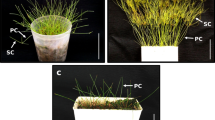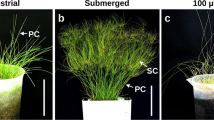Abstract
The leafless amphibious sedge Eleocharis vivipara develops culms with C4 traits and Kranz anatomy under terrestrial conditions, but develops culms with C3 traits and non-Kranz anatomy under submerged conditions. The culms of the terrestrial form have high C4 enzyme activities, while those of the submerged form have decreased C4 enzyme activities. The culms accumulate ribulose-1,5-bisphosphate carboxylase/oxygenase (Rubisco) in the mesophyll cells (MC) and the bundle sheath cells. The Rubisco in the MC may be responsible for the operation of the C3 pathway in the submerged form. To verify the presence of the C3 cycle in the MC, we examined the effects of 3,3-dichloro-2-(dihydroxyphosphinoylmethyl) -propenoate (DCDP), an inhibitor of phosphoenolpyruvate carboxylase (PEPC), on photosynthesis in culms of the terrestrial forms of E. vivipara and related amphibious species, E. baldwinii and E. retroflexa ssp. chaetaria. When 1 mM DCDP was fed via the transpiration stream to excised leaves, photosynthesis was inhibited completely in Fimbristylis dichotoma (C4 control), but by only 20% in potato (C3 control). In the terrestrial Eleocharis plants, the degree of inhibition of photosynthesis by DCDP was intermediate between those of the C4 and C3 plants, at 58–81%. These results suggest that photosynthesis under DCDP treatment in the terrestrial Eleocharis plants is due mainly to fixation of atmospheric CO2 by Rubisco and probably the C3 cycle in the MC. These features are reminiscent of those in C4-like plants. Differential effects of DCDP on photosynthesis of the 3 Eleocharis species are discussed in relation to differences in the degree of Rubisco accumulation and C3 activity in the MC.
Similar content being viewed by others
References
Adams P, Nelson DE, Yamada S, Chmara W, Jensen RG, Bohnert HJ and Griffiths H (1998) Growth and development of Mesembryanthemum crystallinum (Aizoaceae). New Phytol 138: 171-190
Arnon DI (1949) Copper enzymes in isolated chloroplasts: polyphenoloxidase in Beta vulgaris. Plant Physiol 24: 1-15
Brown RH (1997) Analysis of bundle sheath conductance and C4 photosynthesis using a PEP-carboxylase inhibitor. Aust J Plant Physiol 24: 549-554
Brown RH, Byrd GT and Black CC (1991) Assessing the degree of C4 photosynthesis in C3-C4 species using an inhibitor of phosphoenolpyruvate carboxylase. Plant Physiol 97: 985-989
Brown RH, Byrd GT and Black CC (1992) Degree of C4 photosynthesis in C4 and C3-C4 Flaveria species and their hybrids. II. Inhibition of apparent photosynthesis by a phosphoenolpyruvate carboxylase inhibitor. Plant Physiol 100: 947-950
Cheng S-H, Moore BD, Edwards GE and Ku MSB (1988) Photosynthesis in Flaveria brownii, a C4-like species. Plant Physiol 87: 867-873
Chollet R, Vidal J and O'Leary MH (1996) Phosphoenolpyruvate carboxylase: a ubiquitous, highly regulated enzyme in plants. Annu Rev Plant Physiol Plant Mol Biol 47: 273-298
Hatch MD (1999) C4 photosynthesis: A historical overview. In: Sage RF and Monson RK (eds) C4 Plant Biology, pp 17-46. Academic Press, San Diego, California
Hatch MD, Agostino A and Jenkins CLD (1995) Measurement of the leakage of CO2 from bundle-sheath cells of leaves during C4 photosynthesis. Plant Physiol 108: 173-181
Hattersley PW and Browning AJ (1981) Occurrence of the suberized lamella in leaves of grasses of different photosynthetic types. I. In parenchymatous bundle sheaths and PCR (Kranz) sheaths. Protoplasma 109: 371-401
He D and Edwards GE (1996) Estimation of diffusive resistance of bundle sheath cells to CO2 from modeling of C4 photosynthesis. Photosynth Res 49: 195-208
Jenkins CLD (1989) Effects of the phosphoenolpyruvate carboxylase inhibitor 3,3-dichloro-2-(dihydroxyphosphinoylme thyl)propenoate on photosynthesis. C4 selectivity and studies on C4 photosynthesis. Plant Physiol 89: 1231-1237
Jenkins CLD (1997) The CO2 concentrating mechanism of C4 photosynthesis: Bundle sheath cell CO2 concentration and leakage. Aust J Plant Physiol 24: 543-547
Jenkins CLD, Harris RLN and McFadden HG (1987) 3,3-dihydroxyphosphinoylmethyl-2-prope noate, a new, specific inhibitor of phosphoenolpyruvate carboxylase. Biochem Int 14: 219-226
Kanai R and Edwards GE (1999) The biochemistry of C4 photosynthesis. In: Sage RF and Monson RK (eds) C4 Plant Biology, pp 49-87. Academic Press, San Diego, California
Moore BD, Ku MSB and Edwards GE (1989) Expression of C4-like photosynthesis in several species of Flaveria. Plant Cell Environ 12: 541-549
Parvathi K and Raghavendra AS (1997) Both rubisco and phosphoenolpyruvate carboxylase are beneficial for stomatal function in epidermal strips of Commelina benghalensis. Plant Sci 124: 153-157
Spencer WE, Wetzel RG and Teeri J (1996) Photosynthetic phenotype plasticity and the role of phosphoenolpyruvate carboxylase in Hydrilla verticillata. Plant Sci 118: 1-9
Uchino A, Samejima M, Ishii R and Ueno O (1995) Photosynthetic carbon metabolism in an amphibious sedge, Eleocharis baldwinii (Torr.) Chapman: modified expression of C4 characteristics under submerged aquatic conditions. Plant Cell Physiol 36: 229-238
Ueno O (1996a) Structural characterization of photosynthetic cells in an amphibious sedge, Eleocharis vivipara, in relation to C3 and C4 metabolism. Planta 199: 382-393
Ueno O (1996b) Immunocytochemical localization of enzymes involved in the C3 and C4 pathways in the photosynthetic cells of an amphibious sedge, Eleocharis vivipara. Planta 199: 394-403
Ueno O (1998a) Induction of Kranz anatomy and C4-like biochemical characteristics in a submerged amphibious plant by abscisic acid. Plant Cell 10: 571-583
Ueno O (1998b) Immunogold localization of photosynthetic enzymes in leaves of various C4 plants, with particular reference to pyruvate, orthophosphate dikinase. J Exp Bot 49: 1637-1646
Ueno O (2000) Cellular expression patterns of C3 and C4 photosynthesis enzymes in the amphibious sedge Eleocharis baldwinii. Plant Cell Physiol 41 (Suppl): s113
Ueno O (2001) Environmental regulation of C3 and C4 differentiation in the amphibious sedge, Eleocharis vivipara. Plant Physiol 127: 1524-1532
Ueno O and Samejima M (1990) Immunogold localization of ribulose 1,5-bisphoshate carboxylase in amphibious Eleocharis species in relation to C3 and C4 photosynthesis. In: Baltscheffsky M (ed) Current Research in Photosynthesis Vol. IV, pp 867-870. Kluwer Academic Publishers, Dordrecht, The Netherlands
Ueno O, Samejima M, Muto S and Miyachi S (1988) Photosynthetic characteristics of an amphibious plant, Eleocharis vivipara: expression of C4 and C3 modes in contrasting environments. Proc Natl Acad Sci USA 85: 6733-6737
Ueno O, Samejima M and Koyama T (1989) Distribution and evolution of C4 syndrome in Eleocharis, a sedge group inhabiting wet and aquatic environments, based on culm anatomy and carbon isotope ratios. Ann Bot 64: 425-438
Ueno O, Takeda T, Samejima M and Kondo A (1998) Photosynthetic characteristics of an amphibious C4 plant, Eleocharis retroflexa ssp. chaetaria. Plant Prod Sci 1: 165-173
Author information
Authors and Affiliations
Corresponding author
Rights and permissions
About this article
Cite this article
Ueno, O., Ishimaru, K. Effects of an inhibitor of phosphoenolpyruvate carboxylase on photosynthesis of the terrestrial forms of amphibious Eleocharis species. Photosynthesis Research 71, 265–272 (2002). https://doi.org/10.1023/A:1015564708301
Issue Date:
DOI: https://doi.org/10.1023/A:1015564708301




